These are selections from a Penobscot Marine Museum exhibit of 2015, presented here for OCH members to view and study. National Fisherman is the nation’s preeminent publication in the commercial fishing industry, originally a consolidation of earlier, regional fisheries trade papers. I hope you enjoy them, Kevin Johnson, Photo Archivist, Penobscot Marine Museum, Searsport, Maine.
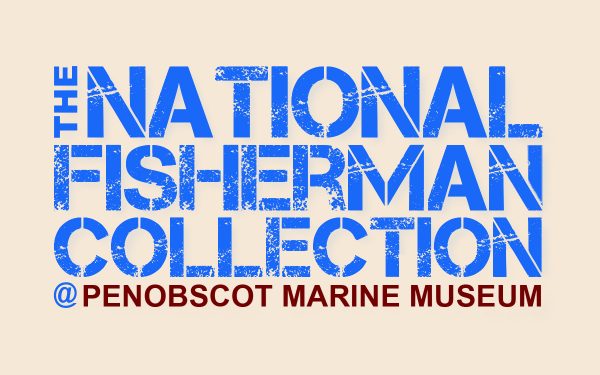
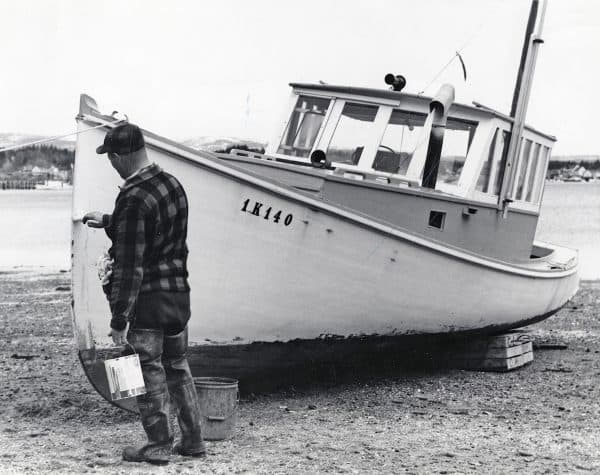
Painting the Lobsterboat. Southwest Harbor photographer W.H. Ballard sent Maine Coast Fisherman magazine this classic photo of a lobsterman painting his boat after grounding it out on a beach—without benefit of marine railway or TraveLift, something no longer practiced. Ballard’s photographs are now at the Southwest Harbor Library. The National Fisherman photo archives have many photos from earlier trade magazines such as Atlantic Fisherman, Pacific Fisherman and Maine Coast Fisherman. (LB2012.15.50 W.H. Ballard photo)
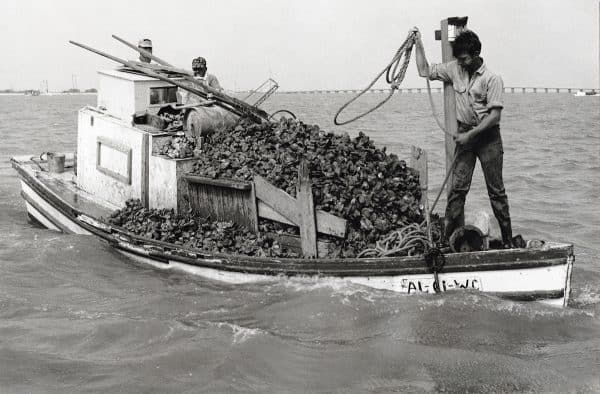
Alabama Oyster Tongers. “Tight decks are needed on Alabama Tonging Boats” was this photo’s published caption. These oyster tongers have done pretty nicely and are hauling their anchor for a careful trip home. Back in 1966, they supplied “steam” oysters for Alabama’s numerous oyster canneries. In the intervening years, however, various parasites have decimated the oyster catches. (LB2012.15.51)
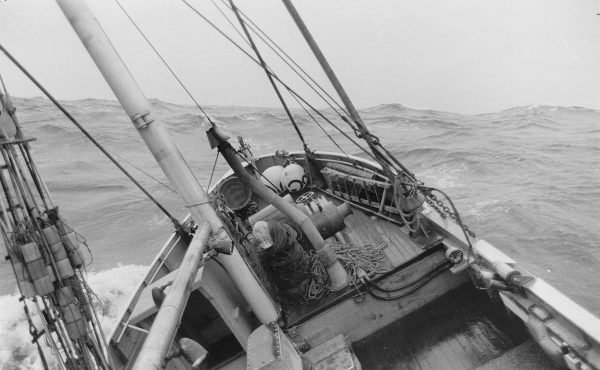
GRANT, 1986. It is a foggy, breezy day as the halibut schooner GRANT slices through Alaskan waters in this photo that ran in the March 1988 National Fisherman magazine. GRANT was built in 1925 in Seattle for Jacob Knutsen and was owned and operated by his son, Jack, in 1986. The GRANT, like other halibut schooners, was a bit of a hybrid. The hull was a powerboat design with a long, horizontal keel and a plumb stem, but she carried sails because the Norwegian owners did not completely trust the internal combustion engine. More than one halibut schooner sailed back across the Gulf of Alaska to Seattle after their engines broke down. (LB2012.15.59)
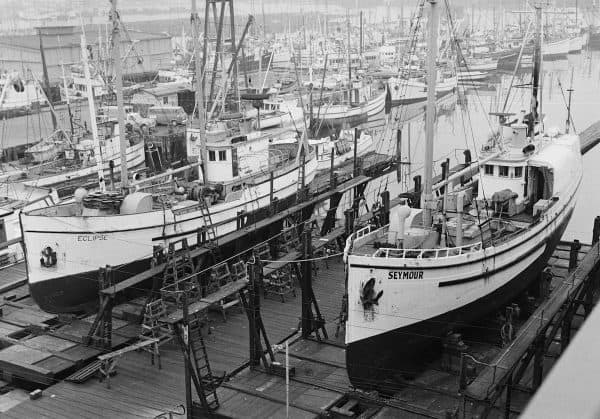
ECLIPSE and SEYMOUR—1970. In between halibut seasons in the Gulf of Alaska and Bering Sea, the wooden halibut schooners ECLIPSE and SEYMOUR were hauled at Seattle’s Fishermen’s Terminal for painting and inspection. These older boats—SEYMOUR of 1913 and ECLIPSE of 1927—required particular attention to their bottom planking and fastenings. ECLIPSE sank a number of years ago, but SEYMOUR continues to fish for halibut and black cod., being one of several halibut schooners still fishing [as of 1970] that are either approaching the 100-year mark or have passed it. (LB2012.15.60)
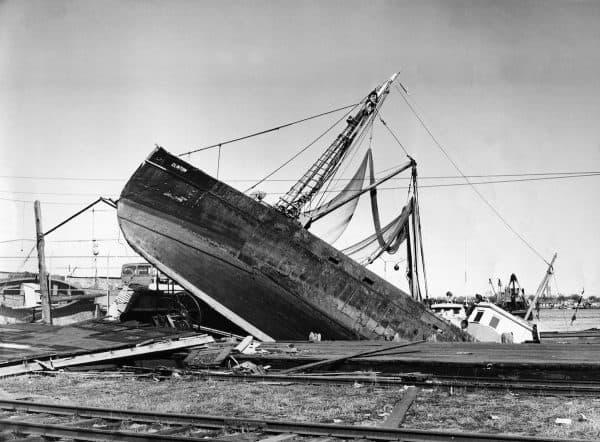
CLINTON Ashore, 1926. This 60’ dragger, built in Thomaston, Maine, in 1925, blew ashore onto the Martha’s Vineyard Pier in New Bedford, Massachusetts, in 1926. She was salvaged and went on fishing for a number of years under different owners. (LB2012.15.72. Photo by Hollywood Studio)
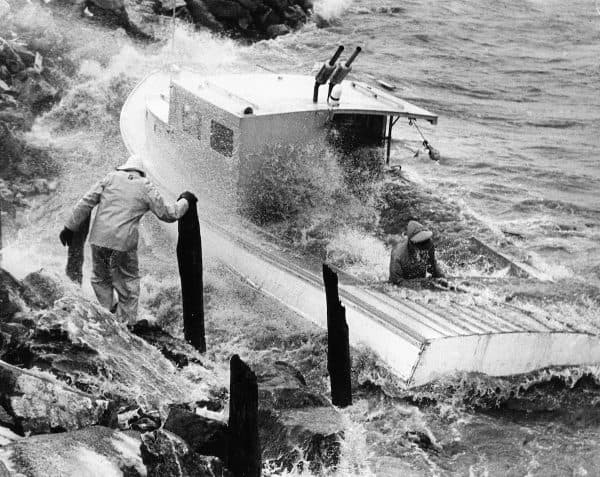
A Bad Day, 1971. The cover of the May 1971 issue of National Fisherman magazine showed this year-old lobsterboat being battered and swamped against a pier in Rockland, Maine, during in a winter gale. Coast Guardsman BMC Stanley H. Metcalf struggled for ten minutes in the sea-swept boat and freezing temperature to prepare the stricken craft for towing, but his effort was in vain. Once pulled off the rocks, the 38’ boat, owned by John Faulkingham, began to sink and had to be cut free of the towline. She then drifted onto a breakwater where she split almost in two. (LB2012.15.73. Photo by Leo L. Chabot)
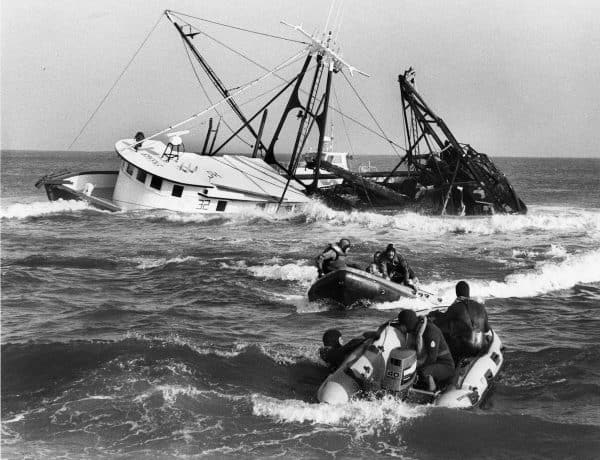
MISS ELEANOR. Divers from the Seaside Park Volunteer Fire Co. head back to shore with the three crewmen rescued from the MISS ELEANOR, a 75 ft. clammer out of Barnegat, New Jersey, after the vessel ran aground at Island Beach State Park. (LB2012.15.74. Photo by Tom Spader)
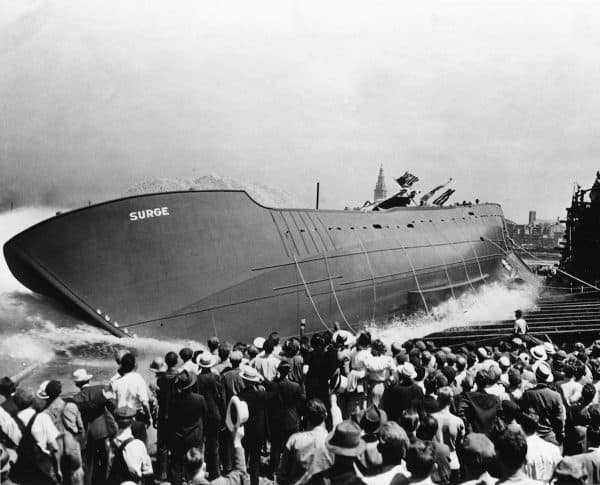
Side Launching, 1941. For the 1985 National Fisherman Yearbook, Michael Crowley provided a summary article on side trawlers entitled, “Early side trawlers changed the U. S. Fisheries forever.” It showed how the US’s first steam trawler, copied from the British, towed a patented otter trawl. The design was then modified in the 1920s when more economical diesel engines that began to appear. Schooner designs that had evolved for dory fishing were modified for diesels and for handling otter trawls; these became known as “Eastern rig” draggers and were the common ground-fishing vessel of choice up until the stern trawlers of the 1970s. Here, the 132’ steel trawler SURGE is being side-launched from Cleveland Shipbuilding in 1941 before joining the New England fishing fleet. (LB2012.15.77)
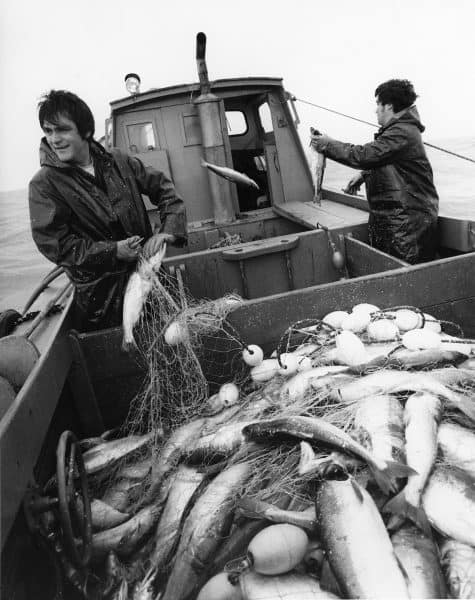
PATTY JEAN, 1980. The 1980 run of sockeye salmon in Bristol Bay, Alaska, was the greatest in the 96-year history of the fishery, but the harvest was not, because fishermen went on strike against the canneries over price. Blockades and near violence marred the season. Once the strike was settled, photographer Marty Loken got aboard the gill netter PATTY JEAN and took pictures of fishermen at their work, creating a rare record of the process. This photograph made the cover of the September 1980 issue of National Fisherman. (LB2012.15.80. Photo by Marty Loken)
****Continue to Part 6
In 2012, Diversified Communications of Portland, ME, donated National Fisherman magazine’s entire pre-digital photographic archive to the Penobscot Marine Museum (PMM). Although the Museum has Fair Use rights to the images, responsibility for determining the nature of copyright and obtaining permissios to publish, transmit or reproduce these materials rests entirely with the researcher.
. . . sign up to the right to get immediate access to this full post,
plus you'll get 10 of our best videos for free.
Get Free Videos& Learn More
Join Now!!for Full Access
Members Sign In
You can leave a comment or question for OCH and members below. Here are the comments so far…












John Brame says:
Almost vegan now but when i get ze boat floating will try to catch a snook or two.
Gord Phillips says:
Re: Painting a lobster boat. Contrary to the comment that beaching boats for painting is no longer practiced, lobster boats on Deer Island, New Brunswick are regularly beached for this kind of work as there are no travel lifts locally available. It’s cheaper, too! It does take two tides to get both sides of the bottom done.
David Tew says:
In the US it’s now frowned upon, if not penalized, to wash, scrub or scrape most antifouling paint, chips, etc., into the waters. It’s a ‘hazardous waste’ issue: https://www.youtube.com/watch?v=N01vrLwAWiM
David Tew says:
Way wrong link above! This one is more on point: https://www.sailmagazine.com/diy/regulations-technology-change-antifouling-paints
John Breiby says:
The photo of “Patty Jean, 1980” sure brings back memories of the strike of 1980. We knew the fish were going past and we were stuck in union meeting trying to get a decent price. By the time the price was set most of the run had gone on by. I think that was the year the canneries had pretty much broken the unions. Today, I think the fishermen are given an “estimate,” but they don’t have a firm price until the season is over.